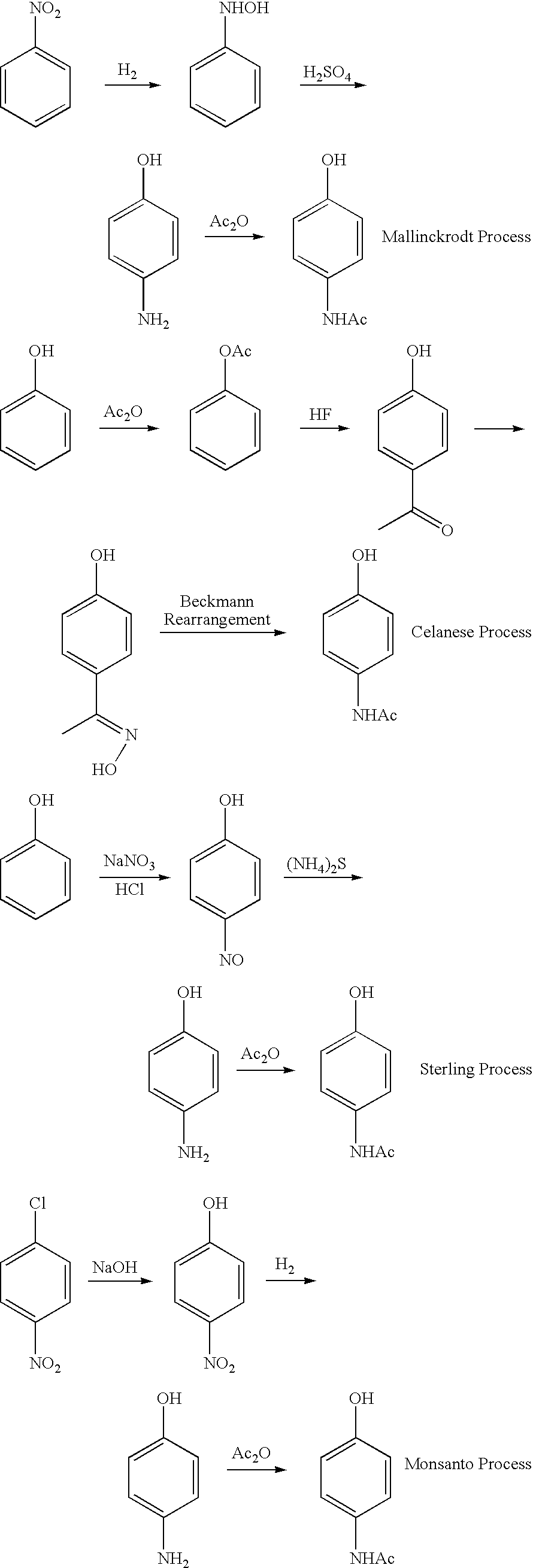Method of producing organic compounds in presence of oxyethylene ether catalyst and in a solvent minimized environment
a technology of oxyethylene ether and catalyst, which is applied in the preparation of carboxylic acid amides, organic chemistry, chemistry apparatus and processes, etc., can solve the problems of limited success in solvent minimization processes, fires and explosions, and prior art requires the use of undesirable solvents, so as to achieve practical and economic attractiveness, and work up small
- Summary
- Abstract
- Description
- Claims
- Application Information
AI Technical Summary
Benefits of technology
Problems solved by technology
Method used
Image
Examples
example 1
Synthesis of Acetaminophen
[0046]This Example illustrates the shortest synthesis of acetaminophen known to date and uses a solvent minimized environment as a one-step amidation / reduction. The Triton X-405 catalyst was heated for half an hour at 130° C. to remove water and then a quantity of potassium thioacetate was added with mixing. Then, one equivalents of p-nitrophenol was added with mixing; all the while maintaining the reaction mixture at 130° C. The progress of the reaction was followed by HPLC analysis using 1:1 acetonitrile:water or solvent at a flow rate of 1 ml / min.
[0047]The p-nitrophenol appeared at a 3.3 minute peak and product “p-hydroxy-acetanilide” appeared at a 1.1 minute peak. Complete disappearance of the starting material occurred in 3.0 hours with the 2.5 hours trace showing 75% “p-hydroxy-acetanilide.” The reaction mixture was then cooled down to room temperature.
[0048]The reaction sequence and the results are presented below:
[0049]
RunPercentTimeNo.RConversion(h...
example 2
Amidations and Reduction Involving Cleavage of Alkyl Group
[0052]An exemplary schematic representation of the chemical reaction is set forth below:
wherein potassium thioacetate is used to cleave a methyl group and reduce a nitro group. Potassium thioacetate can selectively cleave the methyl group from methoxy ether as well as reduce the nitro group to an acetamino group when a higher molar amount of potassium thioacetate is used.
[0053]The reaction was carried out using Triton X-405 in a catalytic amount. A catalytic amount of Triton X-405 was heated at 130° C. for half an hour to remove water and to this a quantity of potassium thioacetate was added with mixing and then one equivalence of p-nitroanisole was added with mixing, all the while maintaining the reaction mixture at 130° C.
[0054]The progress of the reaction was followed by HPLC analysis using 1:1 acetonitrile:water as the solvent at a flow rate of 1 ml / min and UV detection at 254 nm. The product p-methoxy acetanilide and p-...
example 3
Complexation Study on Oxyethylene Ether
[0056]The Triton-X / base combination plays an important role in the rate of the nitroaldol reaction. (As used herein, “base” refers to the inorganic or organic metal containing reagent.) For example, reacting nitropropane with propionaldehyde, utilizing Triton-X-100 as the catalyst, KOH and CsOH were found to be the most effective bases (>90% after 3 h), whereas reactions were slower with LiOH, NaOH and tetrabutyl ammonium hydroxide (approximately 30% completion after 3 hours). No reaction was observed with Ba and Ca or Mg-hydroxide in conjunction with Triton X-100. Triton X-405 was also effective with K, Li and Cs hydroxides. The topology of the Triton-X / ethylene glycol units is believed to be responsible for preferential complexation of metal ions analogous to crown ether complexation of metal ions. In line with these observations, polyethylene glycol (uncapped) and polyethylene glycol dimethyl ether (capped) were also effective when used in c...
PUM
| Property | Measurement | Unit |
|---|---|---|
| flow rate | aaaaa | aaaaa |
| chemical shift | aaaaa | aaaaa |
| chemical shift | aaaaa | aaaaa |
Abstract
Description
Claims
Application Information
 Login to View More
Login to View More - R&D
- Intellectual Property
- Life Sciences
- Materials
- Tech Scout
- Unparalleled Data Quality
- Higher Quality Content
- 60% Fewer Hallucinations
Browse by: Latest US Patents, China's latest patents, Technical Efficacy Thesaurus, Application Domain, Technology Topic, Popular Technical Reports.
© 2025 PatSnap. All rights reserved.Legal|Privacy policy|Modern Slavery Act Transparency Statement|Sitemap|About US| Contact US: help@patsnap.com



